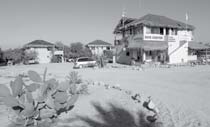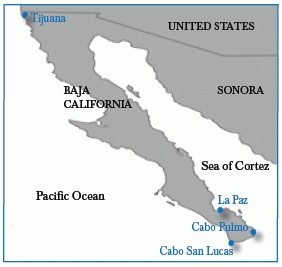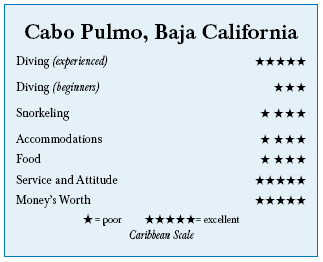Cabo Pulmo Beach Resort, Baja CaliforniaContents of this Issue: Cabo Pulmo Beach Resort, Baja California Vista Sea Sports: Another Good Baja Dive Shop Diversí and Snorkelersí Sunscreen Is Killing Off Coral Barbados, Oman, Puget Sound, Samoa Maui Dive Shop Must Pay $550,000 for Wrecking Reefs Donald Sutherland Claims Diving Is a No-No Past Age 50 Rebreather Deaths Are on the Rise Poor Buoyancy Is a Bigger Factor in Dive Accidents A Rusty BCD Connection Can Rocket You to The Surface Divers Want Marine Parks - - But Donít Want to Pay for Them Shooting Saltwater Up Your Nose Editorial Office: Ben Davison Publisher and Editor Undercurrent 3020 Bridgeway, Suite 102 Sausalito, CA 94965 a pristine dive spot in the Sea of Cortez from the March, 2008 issue of Undercurrent
Dear Fellow Diver: Cruising through El Bajo de los Meros at 50 feet, I was watching a school of porcupine pufferfish browsing on the half-mile-long reef when suddenly everything turned dark. Thousands of two-foot jacks were swimming near the surface. I drifted up to my safety stop, amazed to be in the thick of them. I couldnít see anything but jacks as they lazily swam by me. A peephole opened, large enough for me to see large sea bass and a four-foot-long grouper swimming alongside the school. Just another day on the edge of the Sea of Cortez. Cabo Pulmo National Marine Park is on the southeastern tip of the Baja Peninsula where the Pacific Ocean and the Sea of Cortez meet. Fishing has taken a toll on much of the Sea of Cortez but the marine park, established in 1995, has banned all fishing (though catching big fish like cabrilla, dorado and grouper is allowed just outside its boundaries) so marine life is abundant there, unequaled by any Caribbean venue Iíve visited. And for many North American divers, itís easier to get to.
Cabo Pulmo Beach Resort is 60 miles east of the tourist
epicenter of Cabo San Lucas, but itís a world away
from the hustle, bustle and timeshare salesmen. Forget
about poolside massages
and mariachi
bands Ė this beach
resort is in the
middle of nowhere
and will appeal only
to divers whose big
idea of nightlife is
watching the sunset.
After landing at the San Jose del Cabo airport, my group rented a car for the 90- minute drive. We passed through beautiful desert landscapes on the two-lane road headed toward La Paz, then turned onto a side road to Cabo Pulmo. After the town of La Ribera, the last chance to get extensive supplies and gas, the paved road ended and turned into a six-mile-long dirt road, with some bumps, to Cabo Pulmo. Surrounded by dramatic desert scenery on one side and a two-mile-long stretch of pristine, deserted beach on the other, Cabo Pulmo Beach Resort is a colorful cluster of palapa-roofed cottages with hammocks strung on porches in a tropical beach atmosphere. I had an excellent dinner of tortilla soup, local fish in a chipotle cream sauce and enchiladas at the resortís Coral Reef Restaurant, but the ďlights outĒ signal was at 9:30 p.m. when the restaurantís power generator shut down, so I went to my casita to enjoy the spectacular night sky. A short walk along the resortís bright stucco walls led to a turquoise building a short block from the beach that housed the dive center, resort office and restaurant. After I took my gear there, the eight-person staff set it up and transported it via a red pickup truck to the boat, then retrieved it after the dives and rinsed and stored it. Tanks were aluminum 80s. To dive, I simply put on my wetsuit, hood and gloves and walked to the beach to board the panga for the next two-tank trip. The pickup truck pushed one of the four small outboard-powered pangas to waterís edge, then we divers boarded the boat while the boat captain and divemaster helped the pickup driver push us into the water. They hopped on board and we were under way. You wonít see that in Bonaire. Pancho was my skilled boat captain who, after a quick glance over his shoulder at the mountains or other landmarks, triangulated us right on top of the dive sites. Light currents were common, so we backrolled into the water on the count of three and descended together. While I dived with several divemasters during my week in July, I never felt like crew were playing musical chairs. They are some of the few people who live in Cabo Pulmo year-round and were obviously proud of the marine park. For this side of Baja, they were an exceptionally professional crew. Many of them had years of experience as certified instructors in Roatan. All spoke excellent English and I also heard them speaking French, German and Spanish with daytrippers up from Cabo San Lucas. Each one was eager to point out critters underwater and share stories back on the panga about what they saw. Their thorough briefings included descriptions of the siteís topography, critters we might find, water temperatures, currents and a dive plan. Once they were comfortable with diversí skills, they relaxed their watch and allowed us to dive at our own pace. Dive lengths depended on depth and computers, and were never cut short; many dives went over an hour. Pancho was always waiting when I popped up from dives. I exited by handing up my weight belt and BCD and either climbing the small ladder at the stern or climbing up along the side. Cabo Pulmoís rugged landscape is mirrored underwater, where dramatic rocky crags replace coral in the cooler waters, but itís chock full with colorful marine life of all sizes. Ten minutes from shore, El Bajo de Los Meros and El Moro, a parallel reef, were the longest boat rides. During morning dives at these sites, areas of the reef were ablaze with open orange cup coral. Schools of porcupine puffers, up to 40 a bunch, were everywhere. Same with amberjacks, big-eyed jacks and yellow snappers. I peeked into cracks to see groupers, green moray eels and smaller jewel eels. At El Cantil, layers of ledges offered up a resting turtle, several octopuses,
and pufferfish. Crown-of-thorn sea stars are rare in these parts, so I was thrilled when I saw three at the same site.
Small channels harbored five-foot-long
groupers and dog-toothed snapper. I averaged four dives daily, depths ranging from just under 100 feet at Ed Bajo de los Meros to 45 feet at Las Islote, and most dives were more than an hour long. While I dived with a different group every day, there were never more than six divers on board. They were either experienced American and European divers staying at the resort or day trippers from Cabo San Lucas getting a diving or snorkeling fix. Because of Cabo Pulmoís marine park status, all divers are required to be accompanied by a divemaster. The dive center carefully matched divers and their experience levels when making their groupings. I didnít snorkel but the daytrippers who did raved about their time at La Islote. When they got back in their van, my group pretty much had the restaurant to ourselves until the generator shut down. A storm blew through midway through my week there, sidelining me from diving for a day, but it was a great opportunity to explore topside. A well-marked hiking trail starting in town winds its way back into the mountains for several miles. I was warned to keep an eye out for rattlesnakes sunning themselves on the climb to El Mirador, but luckily I didnít see any. At the top, I sat on the bench atop the mountain to take in the spectacular views both north and south. The desert vegetation is a stunning contrast to the blue sea. The sea view from my casita porch was just as stunning, and I spent postdive downtime lounging in my hammock and listening to the waves. After checking the resort map on its Web site to see how cottages were set up, I called to discuss the diving and pick a unit. I was happy with #8, a casita with rock walls, tiled kitchen and bathroom, and a balcony with hammock. My kitchen was equipped with a propane-powered refrigerator and stove. I always had hot water. My bedroom had a double bed with clean sheets, single-bed futon, chest of drawers and the allimportant pedestal fan. Daytime temperatures in July soared into the low 100s but humidity was low, and my fan kept it comfortable at night, but heat-sensitive divers are better off renting the rooms with a/c. A pleasant shore breeze kept bugs to a minimum. Just outside the sliding door of each casita was a propane barbeque table and chairs, hammock and either a rinse hose or outside shower. Yards were well kept and exploded with lush greenery and bright bougainvillea. Thanks to El NiŮo last year, the water was nearly chilly Ė 64 to 75 degrees, depending on depth and proximity to the shore. July water temperatures typically average in the 80s, but the coolness was refreshing in the furnace-like heat. The pangas are uncovered, however, so I had to bring a hat to keep my face from getting burned. Between topside and underwater explorations, I ate at the Coral Reef Restaurant, on the second floor of the turquoise building housing the dive center. For lunch, I had tasty fish tacos, enchiladas, cheeseburgers and nachos. Dinners started with gazpacho, salads, tortilla soup and calamari, and ended with good entrees like sea bass, shrimp and steaks. Service was excellent, but the restaurant ran short in a few areas. It doesnít offer any dessert, to the dismay of the sweet tooths in my group. BYOB is also a good idea -- the restaurant ran out of beer during our stay, and the beer truck only comes once a week. Iím glad I brought a soft-sided cooler on the trip and stored up on lunch fixings and snacks, because surface intervals between morning and afternoon dives are only 1.5 hours and the Coral Reef runs on its own schedule. On a couple of nights, I ate in town at La Palapa and Los Calalleros, which offered more traditional Mexican food like tacos and burritos and paired the good, hearty fare with sea breezes and million-dollar beachfront views. Dive depths ranged from just under 100 feet at Ed Bajo de los Meros to 45 feet at Las Islote, a small rocky pinnacle that protrudes slightly above the surface. At 75 degrees underwater, it was one of my warmest dives that week. I dropped to its base and swam in a circular pattern, progressing upwards five to 10 feet for every circle of the island. La Islote is a well-tended garden, with rocks thickly covered by multiple sea fans, black gorgonians and colonial cup corals swaying in the current. Schools of trigger fish, Amarillo snapper and grouper were dominant at depth. Lobsters tucked themselves away in the fractures. Two foot-long scorpion fish with heads the size of cantaloupes perched atop the reef. I had hoped to see manta rays and whale sharks but wasnít lucky on either account, but I never tired of seeing large schools of large fish on nearly every dive. Twice I was treated to hundreds of bat rays with up to two-foot wingspans gracefully flying above me, schools as big as cumulus clouds. To my eye, the Cabo Pulmo marine-park protection seems successful. It boasts an abundance of underwater species, from small seahorses to the biggest black sea bass around. It may not equal the Caribbean in terms of colorful coral and clear visibility, but it can hold its own as an underwater aquarium. The wow factor is definitely the large schools of large fish. Many Undercurrent readers have reported problems with resorts on this side of Baja but I found Cabo Pulmo Resort to be a beachfront gem with friendly, relaxed staff and good service despite being in such a remote area. If you want to dive unique reefs with a healthy marine life population and you donít mind your nightlife ending when the generator shuts down, this is a place worth considering. -- Adel Joseph
|

I want to get all the stories! Tell me how I can become an Undercurrent Online Member and get online access to all the articles of Undercurrent as well as thousands of first hand reports on dive operations world-wide
| Home | Online Members Area | My Account |
Login
|
Join
|
| Travel Index |
Dive Resort & Liveaboard Reviews
|
Featured Reports
|
Recent
Issues
|
Back Issues
|
|
Dive Gear
Index
|
Health/Safety Index
|
Environment & Misc.
Index
|
Seasonal Planner
|
Blogs
|
Free Articles
|
Book Picks
|
News
|
|
Special Offers
|
RSS
|
FAQ
|
About Us
|
Contact Us
|
Links
|
3020 Bridgeway, Ste 102, Sausalito, Ca 94965
All rights reserved.


 Itís just outside the
ďtownĒ of Cabo Pulmo,
actually a small village
of 113 people,
with a dirt road running
past a few homes, two restaurants and three dive shops, all
running on solar power and generators.
Itís just outside the
ďtownĒ of Cabo Pulmo,
actually a small village
of 113 people,
with a dirt road running
past a few homes, two restaurants and three dive shops, all
running on solar power and generators. The
rocky topside of the reef, sloping
down to 55 feet, is covered in elegant
stony coral, a safe place for schools
of guinea fowl puffers. I often spotted
guitar fish and bullseye stingrays buried
in the sandy flats with only their
bulging eyes protruding. On our way
to La Esperanza for an early morning
dive, Pancho noticed the dorsal fin of
a small tiger shark break the surface
alongside the boat. In the afternoon,
I spotted a sea lion sunning itself on
the rocks at Pulmo Point.
The
rocky topside of the reef, sloping
down to 55 feet, is covered in elegant
stony coral, a safe place for schools
of guinea fowl puffers. I often spotted
guitar fish and bullseye stingrays buried
in the sandy flats with only their
bulging eyes protruding. On our way
to La Esperanza for an early morning
dive, Pancho noticed the dorsal fin of
a small tiger shark break the surface
alongside the boat. In the afternoon,
I spotted a sea lion sunning itself on
the rocks at Pulmo Point. Diverís Compass: Cabo Pulmo Beach Resort rates range from $49-$69 for
a basic room to $199-$229 for a private beachhouse that sleeps eight
. . . Nonstop flights to San Jose del Cabo airport are approximately
$1,100 from New York, $600 from Chicago and Atlanta, and $300 from
Los Angeles . . . To get from the airport to Cabo Pulmo, rent a car
($40 daily on average) or hire a van (flat rate of $160 each way)
. . . Best grocery store is the MegaMart, 15 minutes from the airport;
bring a soft-sided cooler bag to carry refrigerated items . . .
Dinner at the Coral Reef averaged $35 for two; in-town dining options
are La Palapa and Los Caballeros, but they only accept cash . . . You need a certified
wristband to dive in the marine park, which costs $4 . . . The best time to
dive is between July and mid-November when water temperatures are in the 80s; water
temps are 60s to 70s in winter and spring . . . Cabo Pulmo Beach Resort Web site:
Diverís Compass: Cabo Pulmo Beach Resort rates range from $49-$69 for
a basic room to $199-$229 for a private beachhouse that sleeps eight
. . . Nonstop flights to San Jose del Cabo airport are approximately
$1,100 from New York, $600 from Chicago and Atlanta, and $300 from
Los Angeles . . . To get from the airport to Cabo Pulmo, rent a car
($40 daily on average) or hire a van (flat rate of $160 each way)
. . . Best grocery store is the MegaMart, 15 minutes from the airport;
bring a soft-sided cooler bag to carry refrigerated items . . .
Dinner at the Coral Reef averaged $35 for two; in-town dining options
are La Palapa and Los Caballeros, but they only accept cash . . . You need a certified
wristband to dive in the marine park, which costs $4 . . . The best time to
dive is between July and mid-November when water temperatures are in the 80s; water
temps are 60s to 70s in winter and spring . . . Cabo Pulmo Beach Resort Web site:
